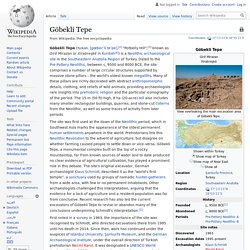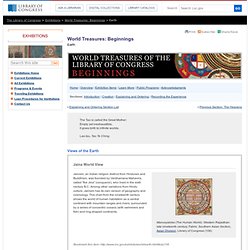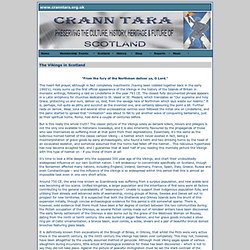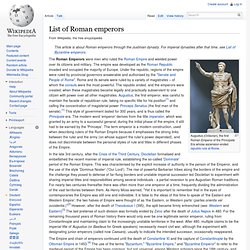

Göbekli Tepe. Neolithic archaeological site in Turkey First noted in a survey in 1963, the importance of the site was recognised by Schmidt, who directed excavations there from 1995 until his death in 2014.

Since then, work has continued under the auspices of Istanbul University, Şanlıurfa Museum, and the German Archaeological Institute, under the overall direction of Turkish prehistorian Necmi Karul. It was designated a UNESCO World Heritage Site in 2018, recognising its outstanding universal value as "one of the first manifestations of human-made monumental architecture".[5] As of 2021[update], less than 5% of the site has been excavated.[6] Background Göbekli Tepe was built and occupied during the Pre-Pottery Neolithic (PPN)—the earliest division of the Neolithic period in Southwest Asia—which is dated to between 9600 and 7000 BCE. Known PPN sites in the Urfa region. PPN villages consisted of clusters of stone or mud brick houses, and sometimes substantial monumental or 'communal' buildings.
Fill Art. Stenka Razin. Cossack leader Stepan Timofeyevich Razin (Russian: Степа́н Тимофе́евич Ра́зин, Russian pronunciation: [sʲtʲɪˈpan (ˈsʲtʲenʲkə) tʲɪmɐˈfʲeɪvʲɪtɕ ˈrazʲɪn]; 1630 – June 16 [O.S.

June 6] 1671), known as Stenka Razin (Стенька), was a Cossack leader who led a major uprising against the nobility and tsarist bureaucracy in southern Russia in 1670–1671. Early life[edit] Razin's father, Timofey Razya, supposedly came from a suburb of Voronezh, a city near Russia's steppe frontier, called the Wild Fields. Razin's uncle and grandmother still lived in the village of New Usman' or Usman' Sobakina, 8 kilometres (5.0 mi) outside of Voronezh, until 1667. Protracted wars with Poland in 1654–1667 and the Russo-Swedish War (1656–1658) put a heavy burden upon the people of Russia. Roanoke Colony. Former colony in present-day Dare County, North Carolina, United States Lane's colony was troubled by a lack of supplies and poor relations with the local Native Americans.

While awaiting a delayed resupply mission by Richard Grenville, Lane decided to abandon the colony and return to England with Francis Drake in 1586. Grenville arrived two weeks later and left a small detachment to protect Raleigh's claim.[1]:70–77 In 1587 Raleigh sent White on an expedition to establish the Cittie of Raleigh in Chesapeake Bay. However, during a stop to check on Grenville's men, flagship pilot Simon Fernandes insisted that White's colonists would remain on Roanoke.[1]:81–82, 89 White, however, returned to England with Fernandes, intending to bring more supplies back to his colony in 1588.[1]:93–94.
History, Travel, Arts, Science, People, Places. A Visual History of Urbanization, 3700 BC to 2000 AD.
Earth - World Treasures: Beginnings. The Tao is called the Great Mother; Empty yet inexhaustible, it gives birth to infinite worlds.

Lao-tzu, Tao Te Ching. Views of the Earth Jaina World View Jainism, an Indian religion distinct from Hinduism and Buddhism, was founded by Vardhamana Mahavira, called "the Jina" (conqueror), who lived in the sixth century B.C. Among other variations from Hindu culture, Jainism has its own version of geography and cosmology. Manusyaloka (The Human World). Bookmark this item: Sacred Cows. Vikings in Scotland. Cattle die, kinsmen die The self must also die; but glory never dies, for the man who is able to achieve it.

The moral code of the early Vikings is summed up in the sagas with examples of “praiseworthiness”, which are listed in Appendix 1. It can be seen from these that, although some of their code may appear a little brutal to the modern mind, particularly to those whose adherence to political correctness is of the zealot variety, the ideals and mindset of the Vikings was well-suited to their relatively harsh environment and the flourishing of their local communities. Living by this code would not be too difficult for most people of the time, as its inherent righteousness is too easily apparent.
Perhaps it may be insufficiently gender-generous for the modern feminist, but that is to examine it too closely with a contemporary mindset, and also to conveniently forget that women played just as specific a part in daily life then as they do today. Scottish History, Tartan, Clans, Music, Food. BBC Radio 4 - In Our Time - Episodes available on BBC iPlayer. Roman Empire. List of Roman emperors. Augustus (Octavian), the first Roman Emperor of the Principate Era whose ascension ended republic rule at Rome.

The Roman Emperors were men who ruled the Roman Empire and wielded power over its citizens and military. The empire was developed as the Roman Republic invaded and occupied the majority of Europe. Under the republic, regions of the empire were ruled by provincial governors answerable and authorised by the "Senate and People of Rome". Rome and its senate were ruled by a variety of magistrates – of whom the consuls were the most powerful. The republic ended, and the emperors were created, when these magistrates became legally and practically subservient to one citizen with power over all other magistrates. Legitimacy[edit] Lists of legitimate emperors are therefore partly influenced by the subjective views of those compiling them, and also partly by historical convention. Emperors after 395[edit]
Leading statesmen of the Roman Republic.